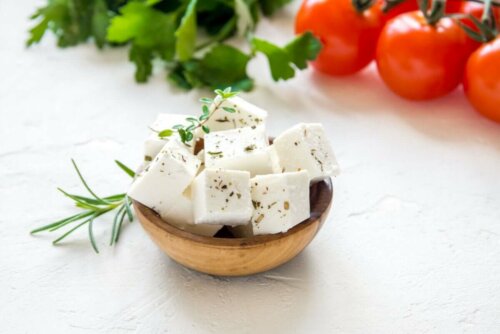Everything You Need to Know About Feta Cheese


Written and verified by the nutritionist Saúl Sánchez Arias
Feta cheese is a dairy product from the Greek culture that has gradually spread to many other countries thanks to its versatility and properties. It’s sold in brine, and this increases its shelf life.
The product is made from sheep’s milk, although it’s also possible to acquire varieties whose main ingredient is mare’s milk. It has a characteristic acidic taste and has a high percentage of fat concerning the total calories. It’s usually commercialized in wooden boxes or in tin or aluminum containers that preserve its taste, smell, and consistency.
The nutritional properties of feta cheese
Like any other dairy product, feta cheese stands out for its protein content, as current scientific literature points out. These are nutrients of high biological value, which have all the essential amino acids and are also highly digestible.
Protein is fundamental to prevent illnesses and conditions associated with aging and with the degeneration of muscular tissue. A review published in the magazine Nutrients shows us that protein consumption helps to delay and prevent the destruction of lean tissue and the loss of its functionality.
As if this weren’t enough, feta cheese contains a high proportion of saturated fatty acids in its composition. Until recently, this would be taken as bad news. However, science has recently changed its position in this respect.
Saturated lipids are no longer considered harmful. Today, scientists recognize their benefits, as there is sufficient evidence to affirm that these fatty acids help to reduce the risk of cardiovascular conditions, as well as the incidence of other complex diseases.

Get to know more: What Is Whey Protein and Who Should Drink It?
Micronutrients in feta cheese
Feta cheese’s macronutrient content is important, but it also contains minerals and vitamins that are beneficial to health. One example here is calcium.
Scientists have proved that the intake of dairy products helps to reduce the risk of osteoporosis because of their calcium content. Feta cheese, therefore, is no exception to this.
In addition to this, it contains significant quantities of vitamin D in its composition. This nutrient is key to maintaining good health, as well as for the prevention of complex, cardiovascular, and metabolic illnesses. In fact, certain types of cancer even have a better prognosis when the body has adequate vitamin D levels. In addition to this, there’s evidence that it can help to protect from skin cancer.
Paradoxically, the general population is generally quite deficient in levels of this nutrient. To guarantee its daily intake, it’s a good idea to consume dairy products (such as feta cheese), bluefish, and eggs. In addition to this, experts recommend frequent safe exposure to sunlight to stimulate its synthesis in the body.
You may also be interested in: Should We Take Vitamin D as a Supplement?
Feta cheese recipes
Next, we’re going to show you two simple recipes with feta cheese so that you can start introducing this food into your dietary routine.
In the oven
Feta cheese can be prepared in the oven, similar to the Italian cheese provolone. With a simple combination of spices, such as oregano, thyme and pepper, and an olive oil dressing, you have a very tasty dish!
The only thing to do is to put it in the oven for 8 minutes at a temperature of 200 degrees Centigrade (400 degrees Fahrenheit), with heat from above and below. When you take the product out, we recommend seasoning it again with a splash of olive oil.
Salad
Salads are a great excuse to eat feta cheese. Just cut the cheese into small cubes and add it to your favorite combination of salad ingredients.
After that, dress it with olive oil and vinegar to get a delicious and nutritious salad. If you want to increase its protein content still further, then add some canned tuna.

The benefits of feta cheese
As you’ve seen, feta cheese is a very beneficial dairy product for our health when consumed regularly. Its protein, fat, and micronutrient content make it a food capable of covering our daily nutritional requirements and helping to prevent the different diseases.
It’s a very versatile product and can be prepared in different ways. On the one hand, you can make it the main ingredient. Alternatively, you can use it as an accompaniment to provide a touch of acidity and contrast to other dishes.
Whatever the case, make sure to include it in your diet from now on. You won’t regret it!
All cited sources were thoroughly reviewed by our team to ensure their quality, reliability, currency, and validity. The bibliography of this article was considered reliable and of academic or scientific accuracy.
- Tessier AJ., Chevalier S., An update on protein, leucine, omega 3 fatty acids, and vitamin D in the prevention and treatment of sarcopenia and fucntional decline. Nutrients, 2018.
- Szajewska H., Szajewski T., Saturated fat controversy: importance os systematic reviews and meta analyses. Crit Rev Food Sci Nutr, 2016. 56 (12): 1947-51.
- Thorning TK., Raben A., Tholstrup T., Soedamah Muthu SS., et al., Milk and dairy products: good or bad for human health? An assessment of the totality of scientific evidence. Food Nutr Res, 2016.
- Anagnostopoulos AK., Tsangaris G., Feta cheese proteins: manifesting the identity of Greece’s national treasure. Data Brief, 2018. 19: 2037-2040.
- Gilaberte, Y., et al. “La vitamina D: evidencias y controversias.” Actas dermo-sifiliográficas 102.8 (2011): 572-588.
- Álvarez, A. Alonso, V. Martínez Suárez, and J. Dalmau Serra. “Profilaxis con vitamina D.” Acta Pediátrica Española 69.3 (2011).
This text is provided for informational purposes only and does not replace consultation with a professional. If in doubt, consult your specialist.








